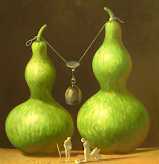NYC Art Bridge
An emotional wellness of art
--Wilhelm Worringer (1881-1965), “Abstraction and
Empathy, A Contribution to the Psychology of Style

NYC Art Bridge is an exciting and innovative initiative that
aims to bring together different sectors of the community to exchange ideas
around mental health and art. By creating a network that includes art
professionals, mental health professionals, families, and individuals, the
initiative provides a safe and culturally-informed space for discussion of
experiences and feelings about mental health. The focus on collaboration,
beauty, and harmony speaks to the potential for art to serve as a unifying force
that brings together people of various backgrounds and experiences.
While the aesthetic sense of antiquity is inadequate to
explain all of art history, a more modern and comprehensive view sees art
creators as driven by an inner need and seeking self-activation through a
process of empathy, allowing mankind to locate itself in relation to the
cosmos. Empathetic art can take various forms and reveal itself as a natural
vitalization or a psychic impulse. However, while the concept of empathy
explains some parts of art well, it fails to value the full artistic panoply.
To complement empathy, Worringer famously appealed to abstraction. The
selection of artists presented in NYC Art Bridge promotes a discourse on the
concepts of empathy and abstraction in an aesthetic system.
Through art creation and discussion, people can travel
towards mental wellness as they explore and express their emotions and
thoughts. Rather than merely attempting to capture the outer world, they strive
to redeem the given object through the transformative power of art.
Having deliberate discussions with these artists can yield
deeper insights into the inspiration behind their artworks, and how their
personal experiences condition their artistic practices. These interviews can
also help foster a sense of community among participants and promote open and
honest conversations about mental health and wellness.
It may be argued that the highest beauty and artistic
fulfillment can only be achieved when the artist expresses ideas that are in
harmony with the appearance of the outer world. This may involve confronting
our spiritual dread of time and space, which can be bewildering but can also
lead to a deeper understanding of the world.
Medical science has recognized the potential of art in
revealing mankind's creativity and promoting mental wellness, which can help
individuals enter into a relationship of friendly confidence with the outer
world and lead to a shift from the practical, material world towards a more
abstract and peaceful expression. By exploring these themes and showcasing the
work of diverse artists, the NYC Art Bridge program facilitates a meaningful
dialogue about mental health and emotional wellness in our community.
The exhibit highlights the importance of artistic volition
and how it has evolved to encompass a wide range of styles and media. It also
emphasizes the impact of cultural experience and community on artistic
expression and how it can inspire innovation and creativity. Artists use their
unique life experiences to create art that can provide a new perspective on the
universe and ourselves. For example, Huey-min Chuang's paintings and drawings
about her personal journey, Cecile Chong's video about language learning, Poyen
Wang's animation showing a lonely boy, Hsin-yi Liu's painting of a busy teddy
bear, and CHATogether's graphic novel about parenthood all offer different ways
of looking at the world and potentially inspire viewers to reflect on their own
lives.
Leo Tolstoy's perspective on art as a means of communication
and progress is particularly relevant to the importance of art in bridging the
gap between different cultures and communities. In the Asian community, belief
often takes precedence over scientific psychiatric treatment, leading to a need
for alternative approaches to addressing mental health concerns. Hence, art can
provide a means of expression and communication that transcends cultural and
linguistic barriers.
Moreover, by emphasizing the imperfections and
inconsistencies of life, art encourages a sense of empathy and compassion among
individuals, promoting social and emotional healing. This aligns with Tolstoy's
notion of art as a means of defining the highest good at which society aims,
and agrees with Worringer’s recognition that every style of art represents the
“maximum bestowal of happiness for the humanity that created it,” and his
feeling that this should be the supreme dogma of all objective consideration of
the history of art.
Exploring the dimension of artistic volition and bringing
together artists, mental health professionals, and the public in a
cross-disciplinary setting, NYC Art Bridge can help promote emotional wellness
and facilitate frank discussion about important issues facing our community. By
addressing themes such as bias against the AAPI community and the immigrant
experience, the project can help raise awareness about pressing social and
cultural issues while also providing a platform for artists to express themselves
and showcase their work.
Now, art can serve as a means to explore deeper aspects of
human existence and the world around us, including spiritual and philosophical
dimensions. Hence, through artistic expression, artists can convey complex
emotions and ideas that might be difficult to put into words, and thereby
enrich our understanding of ourselves and the world we inhabit. Ultimately, the
goal of NYC Art Bridge is to provoke discussion of the urgent social issues of
the moment.
References:
Worringer W. Abstraction
and Empathy: A Contribution to the Psychology of Style, International
Universities Press, New York, 2014
Tolstoy, L. What is
Art? Digireads.com Publishing, 2020
Mukařovský, J., Abstract
Functions, in Harrison C and Wood P, Art
Theory 1900 - 2000, Blackwell Publishing 2006
Schapiro, M., The
Social Bases of Art, in Harrison C and Wood P, Art Theory 1900 - 2000, Blackwell Publishing 2006






%20x%2036(W).jpg)



hi
ReplyDelete